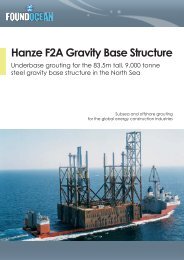UNEXPLODED ORDNANCE - Wind Energy Network
UNEXPLODED ORDNANCE - Wind Energy Network
UNEXPLODED ORDNANCE - Wind Energy Network
You also want an ePaper? Increase the reach of your titles
YUMPU automatically turns print PDFs into web optimized ePapers that Google loves.
SPONSORS OF Unexploded Ordnance<br />
UXO<br />
Other less evident incidents<br />
which may initiate a company’s crisis<br />
management system..:<br />
• Forecast of a severe storm which may<br />
impact operations – do you hope it’s<br />
not too bad a storm<br />
• Public protest against technology used<br />
or the company – do you hope it<br />
doesn’t get too much publicity<br />
• Recall notice from a supplier of a<br />
faulty component which has safety or<br />
environmental implications if was to fail<br />
– what if it effects all your installations<br />
• Damage and/or failure to a data centre<br />
which is key to operations – how will<br />
the operation continue<br />
• Pandemic incident e.g. bird flu – do<br />
you protect your company personnel<br />
Of course no system will prevent these<br />
incidents, but a management system will<br />
certainly mitigate the potential damage<br />
if such an event turns into a crisis or<br />
emergency for the company.<br />
Focus<br />
Crisis management is focused on<br />
the management and resolution of<br />
emergencies and crises that affect the<br />
business with the objective to keep the<br />
business operational before, during and<br />
after a disruptive incident.<br />
Strategy<br />
Every operating company should have a<br />
CM strategy in place that is backed with a<br />
response philosophy, response priorities<br />
and response process that are tested at<br />
defined frequencies through exercises.<br />
Exercises provide an opportunity to<br />
validate plans, assess individual and<br />
team capacity and gain lessons learned<br />
to help increase response capability. A<br />
tiered response approach is appropriate<br />
dependent on the potential impact of the<br />
incident.<br />
One would suggest the<br />
response priorities should be...<br />
• People – employees, contractors,<br />
suppliers, customers<br />
• Environment – air, water, land and<br />
areas of sensitivity<br />
• Property – company assets,<br />
contractors, communities and third<br />
party facilities/offices<br />
• Business – supply, production and<br />
reputation<br />
Live process<br />
CM is a live process that requires training<br />
to be put in place with routine exercises<br />
possibly on an annual basis. Training will<br />
ensure roles and responsibilities are clear<br />
and personnel competent for their role.<br />
Whereas exercises provide an opportunity<br />
to do the following...<br />
• Validate plans (i.e., individual elements,<br />
inter-related elements or entire plans)<br />
• Assess individual and team capability.<br />
Lessons learned from exercises can<br />
be used to improve some or all of the<br />
following...<br />
• Plans<br />
• Processes<br />
• Training programmes<br />
• Individual skills<br />
• Team skills<br />
UXO and Crisis Management<br />
Returning to UXO, we may question the<br />
relevancy within Crisis Management but,<br />
like many other risks faced by projects<br />
an UXO incident is one that can derail the<br />
momentum of a project if it arises where<br />
no planning and contingencies have been<br />
made for the occurrence.<br />
In these circumstances<br />
project drivers such as schedule<br />
and costs will be impacted, however<br />
the severity of the impact will depend<br />
on the project’s preparation, speed and<br />
effectiveness and being able to deal with<br />
an UXO incident.<br />
Dealing with UXO contamination<br />
is normally not particularly difficult,<br />
dangerous, or technically challenging<br />
providing the process to mitigate the<br />
risk is properly managed and the work<br />
is conducted by appropriately trained,<br />
qualified, and supervised personnel - all<br />
the elements of CM.<br />
Maintaining business success<br />
Time spent developing a CM strategy is<br />
key to maintaining business success in<br />
challenging conditions, if your company<br />
has one in place then you are well placed<br />
to manage an incident. However, if your<br />
company hasn’t got one then we at NCOE<br />
strongly advise you to consider starting<br />
one now. If an unfortunate event does<br />
happen, time will not allow you to create<br />
or fill the gaps in a CM strategy. The old<br />
adage ‘be prepared’ resonates deeply.<br />
Newcastle Chambers of Engineering<br />
(NCOE)<br />
www.ncoe.co.uk<br />
Click to view more info<br />
www.windenergynetwork.co.uk<br />
27

















